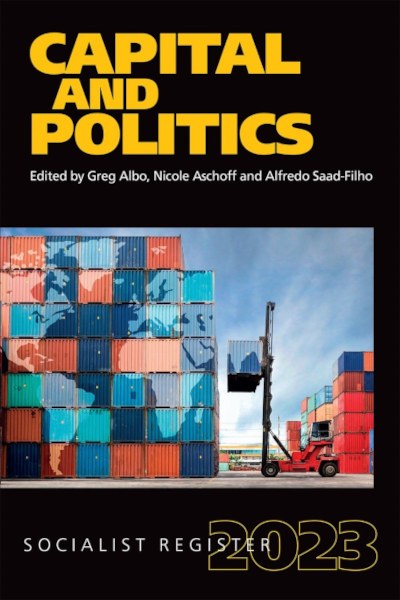Capital and Resistance: A Review of Socialist Register 2023
Socialist Register 2023: Capital and Politics provides what the editors, Greg Albo, Nicole Aschoff, and Alfredo Saad-Filho, describe in the Preface as “a careful accounting of the organizational means by which capitalists accumulate assets and wealth [so as to] understand the parameters of power in capitalist society” (p. x). Knowing the class enemy is central to this volume.
This volume is the first in nearly forty years in which Leo Panitch didn’t play a direct role. Though last year’s volume was produced following his tragic death in 2020, he’d been heavily involved in setting its perspectives and goals. The present volume represents both a tribute to Leo and an effort to carry on, now that his “tenure of editorial leadership” (p. ix) has come to an end.
The book thus has two components. In the first, a taking “stock of ‘capital and politics’ at this enormously complex moment in global capitalism.” There is then a shift to “Leo’s writing and political engagements in the context of the socialist challenge today.” This involves consideration of his “assessment of the making of global capitalism and its consequences for state power and socialist strategy” (p. ix).
Know the Enemy
The first chapter by Adam Hanieh examines transformations in the production of oil. The industry had been dominated by a handful of US and Western European companies, but oil-producing states asserted their interests, and the Organization of Petroleum Exporting Countries (OPEC) was formed in 1960 (p. 3). National oil companies (NOCs) emerged (p. 4) and a “wave of industrial consolidation” among the IOCs occurred, along with a turn “toward environmentally risky, technologically intensive oil production in areas where oil was difficult to extract” (p. 5).
The growth in Asian oil imports prompted a shift in oil refining away from North America and Europe. “Asian refining capacity tripled between 1992 and 2020 so that its share of world refining capacity reached 37%. At the same time, refining capacity in the Middle East “more than doubled between 1992 and 2020” (p. 11).
Despite “the urgency of phasing out oil production altogether,” the twelve largest oil companies “are planning to collectively spend $103-million each day for the rest of the decade on new oil and gas projects… the major oil companies – NOCs and IOCs alike – are driving us squarely toward ecological collapse” (p. 20).
The second chapter, by Nicholas Graham and William K. Carroll, explores climate breakdown and finds a “deep symbiosis between fossil fuels and capital accumulation” (p. 26). This relationship “has only deepened through subsequent phases of capitalist development” (p. 27).
The authors examine the Canada’s dreadful contribution to “extreme extraction,” including “bitumen from the Alberta tar sands, along with fracked shale gas and offshore oil.” Despite questions as to viability, “Canadian business has pursued a sell-out strategy designed to valorize carbon assets by pushing them in volume to market while they still hold value” (p. 29).
The chapter explores the “regime of obstruction” (p. 29) that fossil fuel companies have constructed to minimize action on climate change. It considers “[c]limate capitalism… an emergent accumulation strategy to redirect investments from fossil fuels toward decarbonization and renewable energy” but plausibly characterizes this as an effort to “accommodate pressure” (p. 34) that offers too little too late.
The chapter examines climate-justice movements and advocates an “energy democracy” where “corporate control over production and allocation is replaced with participatory democratic planning” (p. 40).
Corporate Strategies
In the third chapter, by Rafeef Ziadah, explores logistics and the maritime industry. Today, “the management of commodity circulation through complex, networked infrastructures and internationalized supply chains, underpins contemporary capitalism” (p. 48). This “puts emphasis on standardization and systems of management of goods in motion, while minimizing and disciplining the labour time necessary to move them” (p. 49).
The focus of maritime trade has shifted east because of the growing economic power of China (p. 50). There has been considerable concentration of ownership among both port operators and within the shipping industry, reflecting “a strategy of optimizing corporate control over integrated systems of production and circulation” (p. 51).
State-owned enterprises play a considerable role, and two of the five largest port operators are majority state owned. “…the capitalist state remains vital to guaranteeing legal regimes, investment, and financing arrangements” (p. 53).
The shift to containerization and the reordering of the workforce has had an impact, but the supply chains and networks of the new system have their own vulnerabilities. “It is crucial…that the left better understand the pivotal role of operational logistics for the global circulation of commodity capital” (p. 59).
The fourth chapter, by Patrick Bond, considers the crisis of multilateralism in the face of geopolitical turmoil and argues that present upheavals have upset an earlier balance. He considers the example of “vaccine apartheid” (p. 68), the failure to reach consensus on climate action (p. 72), and discord in the face of the invasion of Ukraine (p. 79).
Bond suggests that the “impasse of capitalist multilateralism… needs to be placed in the context of the most intense geopolitical turmoil besetting interstate relations over the neoliberal period” (p. 77). He argues that the “dilemma confronting multilateral economic coordination can be seen as the perpetual problem of how to displace ‘over-accumulated capital’…This is a process which has intensified uneven and combined development everywhere across the world market.”
The role of the West is clear but “[b]ecause they exhibited some of the world’s worst such economic characteristics, the BRICS offered no alternative to a world system where, driven by overaccumulation of capital, territorial tensions continue worsening over how to defend against diverse forms of wealth devaluation” (p. 78). Thus, “…socialist strategies must return to a stage of contestation over local and national power rather than retain fantasies of negotiated multilateral solutions…” p. 84).
In the fifth chapter, Stephan F. Diamond challenges the “corporate governance myth,” traces the emergence of the view that “corporations should be viewed as powerful political institutions and not just as objects of mere economic interest” (p. 92). This has gone over to the notion of “corporate social responsibility.” Thus “many modern stakeholder advocates want to ‘democratize’ the corporate entity” (p. 93).
Diamond argues that corporations “are ruled by capitalists in order that capitalists can rule society.” Their “only ‘purpose’ is to carry out the laws of the capitalist economic system – capital accumulation and valorization – whatever the wider social consequences of that mandate may be” (p. 114).
Next, Charmaine Chua and Spencer Cox explore Amazon’s corporate model as one that is based on “‘just-in-time’ consumer delivery” that integrates “formerly distinct spheres of production, transportation, and consumption into a single e-commerce system aimed at the long-term consolidation and transformation of the retail industry into a vast logistical enterprise” (p. 125).
The authors note that Amazon’s “warehouse model not only reorganized the geographies of supply chain management, and the logistics industry as a whole, but also drew its labour force from the surplus populations increasingly displaced from metropolitan centres” (pp. 132-33).
Under these conditions, “[o]rganizing at the intersection of race and class requires moving into the suburbs (and) [b]uilding bridges across ethnic, racial and gender divides” (p. 135). It also means “[l]abour organizers need to connect shop floor concerns to the issues of working-class people in the cities and communities in which they live” (p. 136).
The chapter concludes by observing that there “is much for the North American left to learn from these struggles to build autonomous working-class organizations rooted in the everyday lives of workers” (p. 138).
Kyle Bailey confronts the concept of “stakeholder capitalism” in the next chapter, focusing on the case of Unilever. He notes that, for major companies, “a legitimation deficit has been steadily rising since the ‘lock-in’ of neoliberal reforms” (p. 143). Corporations have responded by promoting a “reconceiving (of) the intersection between society and corporate performance” (p. 145). They would present themselves as being interested in more than profits.
Faced with the anti-globalization movements of the 1990s, Unilever was one of those that put on a human face. It joined the World Business Council for Sustainable Development and adopted several programs in line with this approach. However, as Bailey shows, this tactical shift isn’t only about a refurbished image; its initiatives “exploit market opportunities” arising from the campaigns that are taken up and promote the “marketization of climate and social justice ‘activism’” (p. 153).
Bailey argues that the “left can’t settle for a ‘multi-stakeholder’ variant of capitalism…(Challenging) the social and ecological harms being wrought by the major corporations today necessitates posing worker-centred, eco-socialist alternatives to capitalist exploitation and social irresponsibility” p. 158).

In the eighth chapter, Richard Saunders looks at efforts to regulate extractive interests and local governments to prevent trade in “conflict diamonds.” This has employed “notions of public participation, tripartism, and transparency in new private-public regulatory conventions” (p. 167). These underlay the formation of the Kimberley Process Certification Scheme (KP) in 2003.
Saunders points out that while “formally multi-stakeholder in membership and internal governance, the new initiatives… were dominated from the outset by industry and government” (p. 167). The Civil Society Coalition (CSC), involved in the KP, “pointed to a rising wave of diamond-related violence in a number of member countries.” However, “[b]y the 2010s, groups of allied governments formed within the KP to blunt efforts at internal KP reforms and derail efforts to sanction non-compliant countries” (p. 169).
The chapter details the consistent thwarting of regulatory efforts and focuses on horrendous examples of corruption and violence in Zimbabwe. Saunders concludes that “African social movements (must) imagine, identify, and build the political and social conditions that will be an essential ingredient in any popular gains on the front of extractive regulation…” (p. 185).
Prospects for Resistance
In the ninth chapter, Minqi Li examines China’s “regime of accumulation,” and the potential for working-class resistance. Long hours and harsh working conditions underlie China’s rapid economic advances. At this time, standard forms of exploitation are being augmented by “‘new patterns of employment’ made possible by platform technologies… as of 2020, 84 million workers were employed in the platform sectors and, and more broadly defined ‘flexible employment’ reached about 200 million” (pp. 191-92).
The chapter shows that, despite grim working conditions, wage growth has maintained a level of social stability. However, this is “now beginning to be overtaken by various living costs that are not fully captured in the official price index” (p. 197), particularly housing costs. Moreover, “[a]s China’s rural surplus labour force approaches depletion, there will no longer be a reserve army of millions of workers who are willing to accept harsh working conditions in exchange for higher living standards if they move into urban areas” (p. 202).
Already, young workers are ‘lying flat’ and “refusing to marry, have children, or participate in the pursuit of unnecessary consumption” (p. 203). This may be an early indication of a huge intensification of class struggle.
The tenth chapter, by Pun Ngai and Chen Peier, deals with class conflict within high-speed rail (HSR) projects that China has turned to. This must “be understood as a strategic response to the global financial crisis in 2008,” with some 40% of government stimulus going into transportation infrastructure (p. 213). Thus, “a monopolistic railway dominated by state-owned enterprises has gradually been developed for capital valorization, with state backed competitive advantages in both domestic and foreign markets” (p. 215).
The chapter outlines the massive assault on working conditions within HSR projects (p. 217), and it shows how struggles have been taken up within this system (p. 219). It argues that these massive developments can “create internal contradictions that intensify class conflicts and spur the formation of the infrastructural power of labour (and) the struggles that are making a new Chinese working-class” (p. 221).
Next, Armando Boito explores political divisions in Brazil over recent decades, leading up to “neo-fascism” under Bolsonaro. Boito considers this from the standpoint of “cleavages in the Brazilian capitalist class, between a bourgeois fraction that is fully integrated into foreign capital…and another that… seeks to limit the internationalization of Brazilian dependent capitalism” (p. 225).
In a “first attempt to impose neoliberal capitalism” in the 1990s, the section of the bourgeoisie closest to the imperialist powers prevailed (p. 230). The first portion of this century saw the “political program of the big internal bourgeoisie become dominant through the neo-developmentalist economic policy of the PT-led governments…” (p. 230).
Boito argues that the fragmentation of social and economic struggles has led to “the working-classes…being integrated into one of the main bourgeois fractions” (p. 232). This relative weakness allows contending capitalist interests to dominate.
The restored ascendency of neoliberalism was achieved under Bolsonaro. The chapter was written before the victory of Lula, but it notes Bolsonaro’s hostility to the electoral system and how it suggests a “need for neoliberalism to resort to fascism, which destabilizes democracy in Brazil…” (p. 244).
Capitalism and the State
The Register’s final essays considers “Leo Panitch and the Socialist Challenge,” beginning with a chapter by Stephen Mahar and Scott Aquanno on Panitch’s contributions to exploring “the arrangement of social forces, the structure of capitalist class power, the specificity of state institutions, and the like, within a particular historical moment” (p. 247).
The chapter bases its conclusions on a careful examination of “specific institutional forms of capital and state” (p. 248) as they have developed over recent decades. It examines the strategic shifts that have taken place and the central role of the US state within this process.
The authors look at the response to the financial crisis of 2008 and the consolidation of a “risk state” to manage the economy through quantitative easing and other initiatives. “What had seemed at first to be a radical extension of state power into the heart of the financial system was now organic to its routine functioning” (p. 256).
The chapter points to the growth of asset management companies and explores the role of the “Big Three” of these formations. “As the asset management companies are effectively permanent owners of the largest corporations in the economy, equally permanent interconnections between these financiers and industrial corporations” (p. 259).
The plausible conclusion is drawn that the “formation of the new finance capital does not seem to have created space for a meaningful social democratic class compromise. Rather, this has served to entrench the consensus among all factions of capital around globalization and class discipline” (p. 264).
Like all the chapters, this one is marked by the concreteness with which it approaches its subject matter. Firm conclusions are drawn and insights of value to all socialists are presented. Yet the broad conclusions that the authors form left me troubled.
The picture painted is of a system that remains robust. The turn to financialization has been done from a position of strength. Crises happen, but they often make the system stronger. The hegemonic power of US imperialism seems unshakable. We are up against an enormously powerful, if not invincible, opponent by this reckoning.
Yet, can we say that the sluggish recovery that followed the Great Recession was an indication of capitalist strength and stability? Has the “risk state” been so successful in containing the threat of crises that we should accept its long term effectiveness? The US is still hegemonic, but isn’t there some evidence, in the rivalry it faces and its own internal problems and contradictions, that its future looks uncertain?
If we are to consider socialism as a realistic bet, there is no doubt that a conscious political initiative must be taken up and that capitalism won’t fall over by itself. However, this subjective factor may have more to work with, in terms of the limitations and contradictions that exist within the system, than this chapter suggests.
In the next chapter, Panagiotis Sotiris looks at strategies around mass parties with a view to Panitch’s work on these questions. In the last decade or so, a range of left electoral initiatives have unfolded. Their shortcomings prompt the question asking “by which means can the left take state power through a democratic election and begin the process of… socialist transition?” (p. 275).
The author accepts the possibility of “the collapse of the state and forms of more or less violent insurrection” but suggests that an electoral road must be viewed as possible, in order to avoid being “theoretically rigid and politically sectarian” (p. 275). Sotiris points out that Poulantzas rejected the Leninist concept of dual power but feels that “what (Poulantzas) suggests is actually close to a dual power strategy. He insists on autonomous social movements and subaltern organization…” (p. 277).
In my view, despite working class organization existing in both the ‘in and against the state’ approach and a revolutionary perspective, a very different notion of dual power is at play that reflects opposed perspectives with regard to the prospects for transforming the capitalist state.
Sotiris suggests that a “withering away” of the captured capitalist state “can only rest on the increased intervention of the popular masses in the State” (p. 278). This social mobilization will be needed to overcome the “reaction of the enemy,” and we may agree that ruling classes will oppose their own dispossession. It will also be one of “two parallel forms of power – ‘a left government and a second power composed of popular organs” (p. 278). The possibility of major differences between the two is acknowledged, but a creative tension is hoped for.
The concept of dual power that is advanced here isn’t one of independent working-class formations emerging in a period of crisis and representing the basis for a different state power. On the contrary, an elected government takes control of the capitalist state and transforms it into a mechanism to create socialism. The mass working-class organizations in this situation may demonstrate some impatience, but they are working in a partnership and provide the lifeblood for incremental transformation by way of “non-reformist reforms” (p. 283).
Sotiris suggests that “profound changes inside the state, especially with regard to democratic control and oversight over repressive apparatuses such as the police, armed forces and judiciary” could be implemented. In my opinion, the hope that ‘democratic control’ over cops and military commanders can neutralize them is unfounded. The central banks and finance ministries aren’t any better of a prospect. As to the ruling class itself, while it may grant concessions in the face of social mobilization, it won’t be pressured into accepting its own destruction.
I fear that the effort to rework the capitalist state would come to grief and that the dual power that Sotiris envisages would end in a major defeat unless the ‘popular organs’ took matters into their own hands.
Vehicle for Socialism
In the fourteenth chapter, Madeleine Davis explores Leo Panitch’s thinking on the British Labour Party. His last major work was published following the defeat of the Corbyn project, and this cast its shadow over the prospects for “a Labour new left” that could “transcend the limits of parliamentary socialism.”
This task has unfolded within a political institution marked by “its structural integration and subordination within the British class and national system that continually frustrated efforts to transform it into a “‘broadly mass and democratic party capable of acting as a vehicle for socialism” (p. 289).
The chapter provides an overview of Panitch’s contribution to this effort to create a means of advancing socialism. The overall failure to take the Party in such a direction is explored, not only from the standpoint of its right wing and its links to the British establishment but also the shortcomings of the parliamentary left. “Crucially, within the Labour Party itself, the myth of ‘broad church’ unity masked a structural subordination of the left within it” (p. 292).
The emergence of the Starmer leadership and its mission to ensure Labour will be a loyal representative of the ruling establishment would surely reinforce the conclusion that the limits of social democracy are clear and that hopes for a new left must be directed elsewhere.
The final chapter takes the form of an interview with Leo Panitch that was conducted by Rafael Khachaturian entitled “Against Pessimism: A Life on the Left.” In it, Leo speaks of his formative experiences, growing up in a working-class Jewish family in Winnipeg. “My father in particular was a self-educated socialist…it was a political intellectual milieu” (p. 316). He traces his university experiences, his time in Britain, and the enormous influence on his development of Ralph Miliband.
Leo pointedly rejects “value neutral” scholarship and argues that “[of] course, your research is governed, motivated and stimulated by your values… When your research is orientated to its strategic implications, you’ve got to really make sure that you’re not finding inconvenient facts and burying them, because that’s going to affect whether your strategy is right or wrong” (p. 319).
In many dealings with Leo over the years, we often agreed and sometimes disagreed, but the seriousness and integrity that the above quote suggests was always in evidence. Khachaturian’s assertion that he was “one of the most dedicated and tireless intellectuals on the Western left” (p. 313) is fully justified.
This volume of Socialist Register offers a concrete appraisal of the forces of global capitalism and the possibilities for working-class resistance. Each chapter provides information and analysis of considerable importance. The perspectives advanced, especially on the means by which a socialist society can be created, represent an important current of left opinion. As such, this volume should be studied and discussed widely. •






